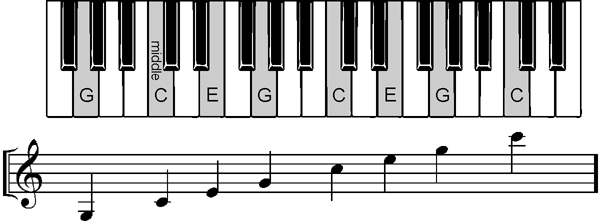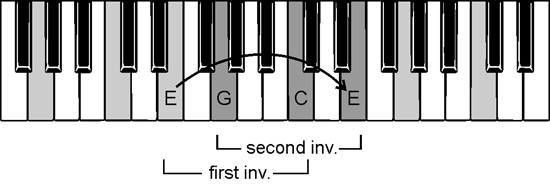Patreon CHORDS 101 Series
Finding the Inversions
- Page One -
Finding the chords you need on the keyboard quickly takes practice. Here are some tried and tested methods that will definitely help. With easy-to-follow instructions, learners of any age and stage can learn and practice them, and teachers can use them with their pupils.
|
Inversions series nav |
Inverting chords
When you’re just starting, the difficulty with learning inversions is that you lose sight of the keys when you take your hand off to move it. The Musicarta method overcomes this initial problem by using two hands – to start with. Make sure you follow the two-hand instructions exactly to get the full benefit.
We will be using the chord tones of C major, shown here (shaded) on a keyboard.

There are three steps in this method, which repeat.
1. Start with a simple C major triad in root position. The right hand plays, using fingers 1, 3, 5. Hold the notes down.

2. Repeat the thumb note. It’s a white-key C. Take just that one note off, but play and hold the next C up the keyboard with your left hand. (Any finger will do.)
You will know you have found the right note because it will look and sound the same as the bottom note you just played.

3. Take those three notes over with your right hand using fingers 1, 2, 5. The bottom note has gone up an octave: the root position chord has ‘inverted’ into a first inversion chord. Play the first inversion chord with your right hand.
The next audio clip covers Steps 1, 2 and 3 all rolled into one:
Repeat steps 1, 2, 3 to climb up from the first inversion chord to the second inversion chord.

4. Repeat the three steps to climb up from the second inversion chord to the root position chord, an octave above where you started.

5. Repeat the three steps to end on a first inversion chord with C, the root, at the top.

Here's a diagram showing what you’ve done.

Inversions descending
To come down, you start from the top first inversion chord using RH fingers 1, 2, 5.

There are three steps to each downward flip.
1. Play your highest first inversion C chord with RH fingers 1, 2, 5 (above). Hold the notes down.
(The audio clip - for all three steps - is below.)
2. Exchange the top note (C, RH5) for the next C down the keyboard – played with your left hand. (Any finger will do.) You should now be holding three notes – two in the right hand (1, 2) and the one left-hand note.

3. Take those three notes over with your right hand using fingers 1, 3, 5. The top note has gone down an octave: the first inversion position chord has ‘flipped’ down into a root position chord. Play the root position chord with your right hand.
(The audio clip is for all three steps.)
4. Continue the three-step process until you get back down to the starting root position chord.



This is what the whole downward movement looks and sounds like.

You can see in this diagram how the inversions we have used in this exercise overlap.

Recap your motivation
To make an inversion, one of the outside notes of a triad jumps an octave over the other two notes, which stay the same.
Root position chords – the ones we usually learn first and can usually always find – are not the nicest-sounding chords. First inversion chords, with the root at the top, are a lot more useful. Second inversion chords, with the third at the top, sound nicer than root position chords, too.
It’s annoying being sent back to First Grade, but using this ‘baby’ two-hand method will teach you to locate your inversions without mistakes and without stress far faster than trial and error and ‘just hoping’.
Exercises
Use your Musicarta Keyboard Chord Generator (Visual Glossary pdf download) to find the major and minor chords in this section.
1. Four flips up and down
Repeat the pattern exactly as you played it here from any Group One root position (circles) chord in the Chord Generator. The following audio file plays the pattern in A minor, then continuously in G major. Practice until you can play along.
2. One flip up, one flip down
Play the root position chord (circles) and flip the chord upwards into first inversion (triangles) and downwards into second inversion (squares) using the two-handed method you’ve just learned.
You’re trying to become as sure about the octave jump and as slick in taking over the three notes with the right hand as possible.
Say out loud which inversion you’re playing as you do these exercises, so that you tie what the inversions look like to its name and sound in your mind.
3. Using Group Two chords
Repeat the above exercises with Group Two chords (one black key).
Start from root inversion (circles). The following audio file plays ‘Four flips up and down’ from root position (circles) in D major, then in C minor. Practice until you can play along.
Next step
Your next step is practicing finding the inversions using just the right hand. Click through to your Patreon Premium Inversions Page Two for a methodical approach to building skills in this area.
|
Inversions series nav |
Hope you're enjoying studying with Musicarta! Come back soon!
|
OUT NOW! |
THE MUSICARTA BEAT & RHYTHM WORKBOOK At last! An effective approach to keyboard rhythm & syncopation skills. Learn more! |
ONLY $24.95! |
PATREON |
The MusicartaA methodical approach to keyboard syncopation for
|
PUBLICATIONS
exciting keyboard
creativity courses
CHORDS 101
WORKBOOK

~HANON~
video course

Musicarta
Patreon
PENTATONICS
WORKBOOK
video course

Creative Keyboard
video course

BEAT AND RHYTHM
WORKBOOK

- Volume 1 -

12-BAR PIANO
STYLES WORKBOOK

MUSICARTA MODES
WORKBOOK

PIANO STYLE

CANON PROJECT
video course

VARIATIONS
video course


- Piano Solo -
video course

- Piano Solo -


YouTube playlists


